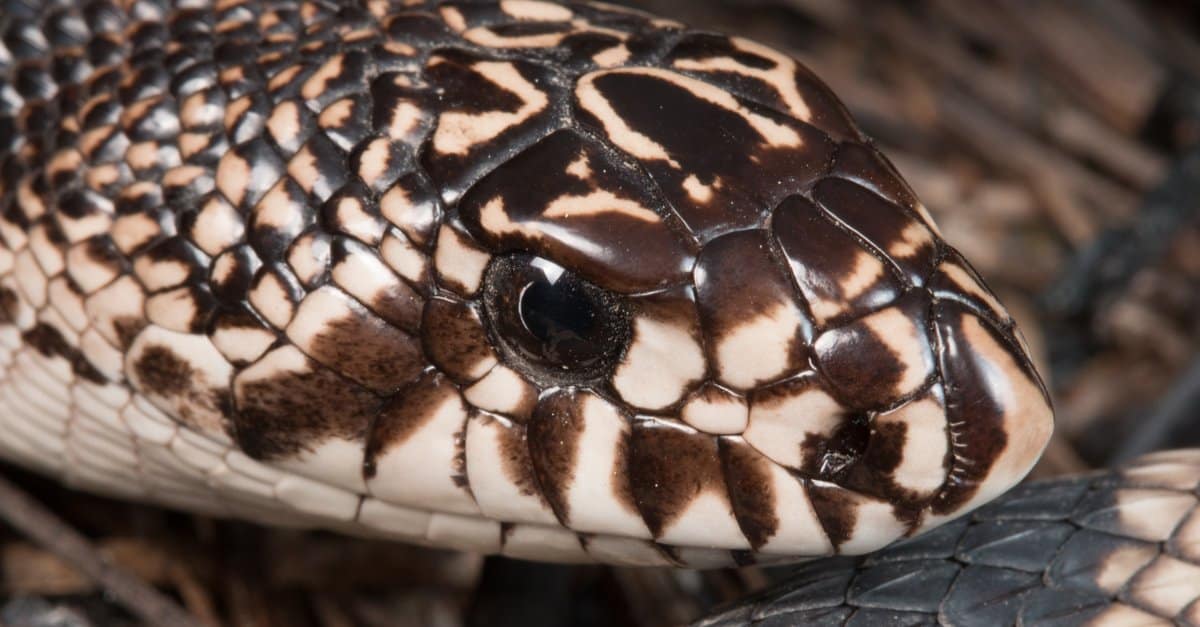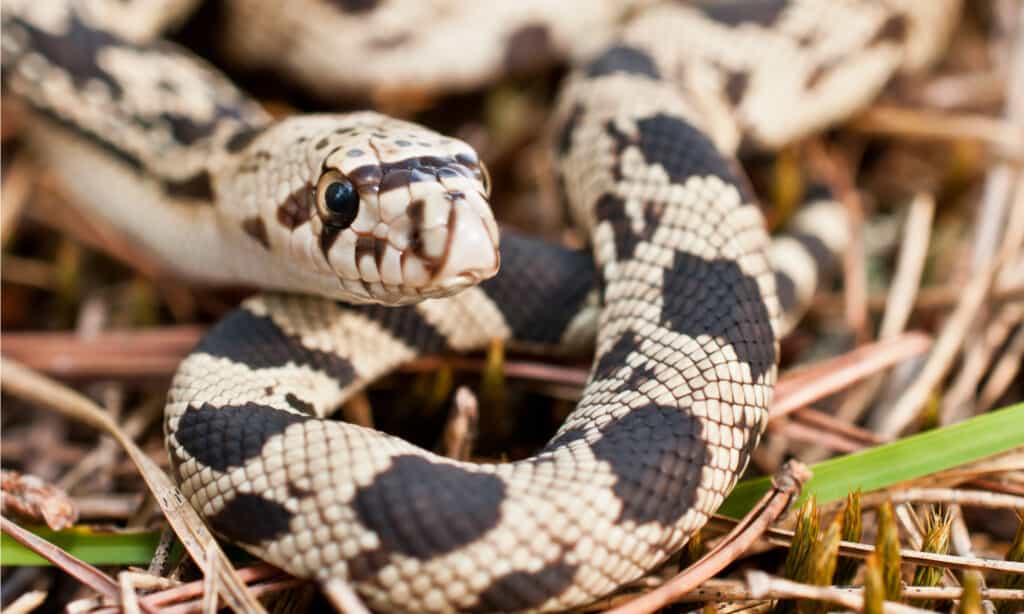
The Pine snake is a nonvenomous snake.
©Jay Ondreicka/Shutterstock.com
Pituophis melanoleucus, most known as the pine snake, is a species of nonvenomous snake in the family Colubridae. Some of Pituophis’s other common names include “gopher” or “bull snake.” It is also sometimes referred to as black and white snake, pilot snake, and horned snake. There are four subspecies of the pine snake. The Florida pine, black pine, Northern pine, and the bullsnake. Some of these snakes can grow the length of an adult human. However, it may be tricky to spot them because they mostly burrow themselves underground. This is, of course, when they’re not busy climbing up trees or coiling up inside bushes.
When it comes to weight and length, many pine snakes average up to 6 feet in length and will grow as thick as a human’s wrist. In fact, these are one of the largest snake species in North America! But how big is the largest pine snake ever recorded? Let’s find out.
Largest Pine Snake Ever Recorded
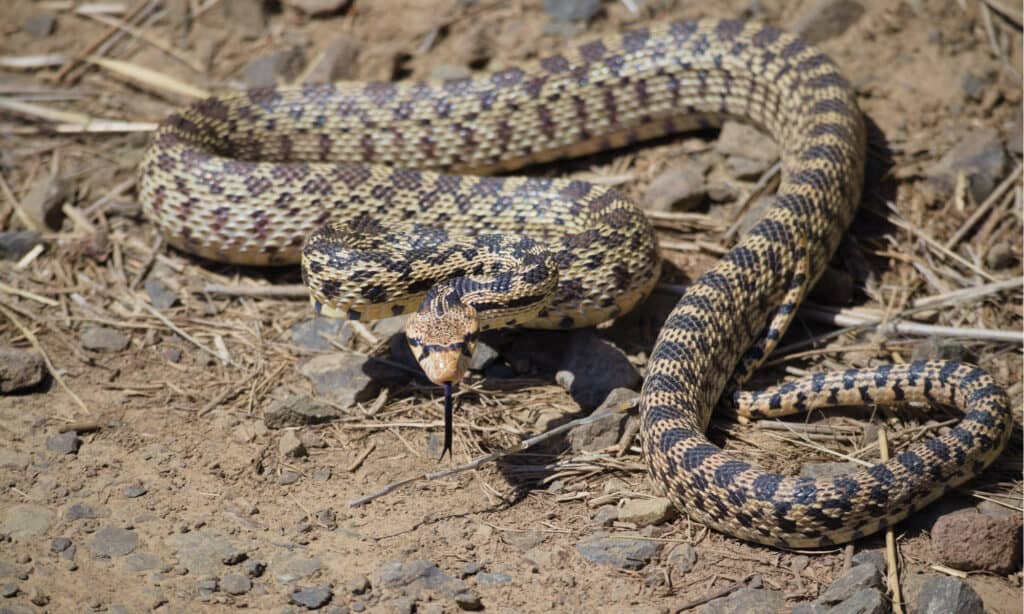
Bullsnakes are the largest type of pine snake.
©Christopher Joe Brown/Shutterstock.com
The largest type of pine snake ever recorded was a bullsnake that grew to about 8.75 feet (105 inches) in length! The bullsnake is the largest snake of the pine snake species. It typically weighs about 3 pounds and averages about 6 feet in length. However, larger specimens have been recorded, weighing between 7 and 9 pounds, and growing up to 7 feet in length!
Pine Snake Lengths by Sub-Species
| AVERAGE ADULT LENGTH (in) | RECORD LENGTH (in) | |
|---|---|---|
| Florida pine | 48 – 66 | 84 |
| Northern pine | 48 – 66 | 83 |
| Black pine | 40 – 60 | 74 |
| Bullsnake | 37 – 72 | 105 |
About Pine Snakes
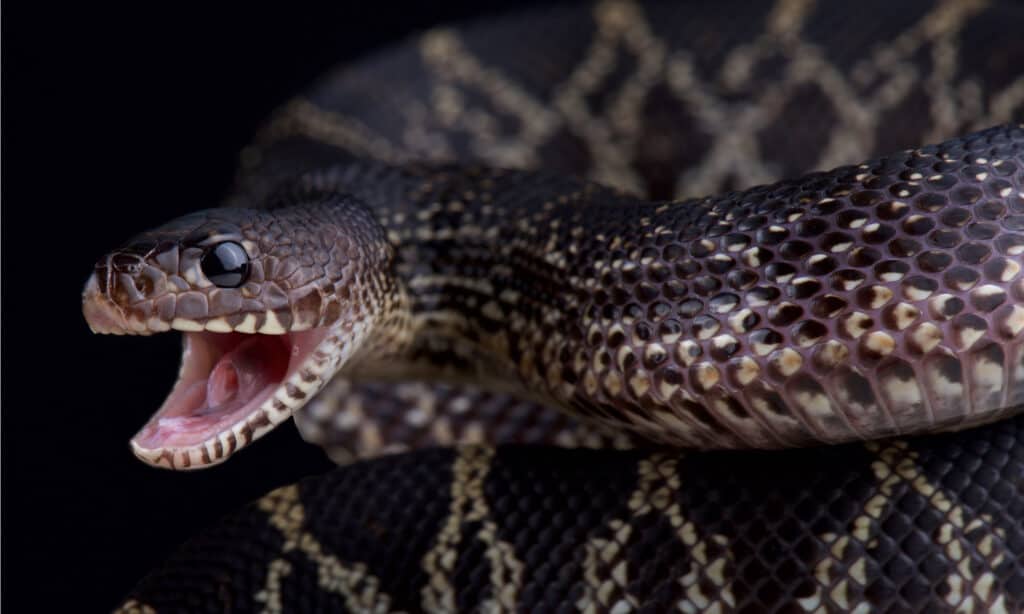
The black pine snake does not have visible blotches.
©reptiles4all/Shutterstock.com
Appearance
Most types of pine snakes have light-colored skin with several blotches of color that can vary from brown to black to even a shade of red. Both the Florida pine and Northern pine snake are very similar in color, with light skin splattered with black blotches. The bullsnake tends to be lighter and will more than likely have reddish-brown blotches but can have black markings as well. The black pine, however, is the subspecies of this snake that does not have any visible blotches or light-colored skin. In fact, this subspecies is as close to jet black as an animal can get! All these snakes have pointy snouts and turtle-like heads, which makes it easier for them to burrow their bodies underground.
Habitat
Pine snakes mostly dwell in the Midwestern and Southeastern areas of North America but have also been recorded in Northwest of the United States and in Canada and Mexico. While most of these snakes tend to reside in woodlands or near forests so that they can have access to soils, they can also live in rocky deserts. Pine snakes need their dwelling grounds to have almost a sand-like texture. This makes it perfect for them to burrow or dig underground so they can hunt for food or hibernate when the air gets too cold or hot.
As mentioned, there are four different subspecies of pine snakes. While you are more than likely to find a northern pine in Canada and states like Wyoming, Montana, and Colorado, you can also find them on the east coast as well. Though, when you travel further south, expect to see more of the Florida pine and the black pine, which are commonly found in Mississippi and Louisiana. The bullsnake, however, can be found virtually anywhere in North America, though a lot of them are also commonly found in Mexico.
Diet
Pine snakes are rodent snakes, meaning they love to eat mice, rats, gophers, moles, and even eggs! Some larger pine snakes may even move on from rodents and eggs, snacking on some larger specimens such as small birds and even small mammals. Juvenile snakes can also consume small mammals, bugs, and even other reptiles such as lizards!
Danger
Just because these are non-venomous snakes, doesn’t mean they are not dangerous. While they aren’t large enough to squeeze around a human, these snakes can get aggressive when encroached upon and will not hesitate to strike at you. Although it is uncommon for them to bite, expect it to be painful if they do. A warning sign before a fast strike from a pine snake may include loud hissing, or vibration and shaking of their tail, mimicking a rattlesnake. They also may let out a loud, bellow-like sound used for intimidation, since their predators can be larger animals such as foxes.
In Conclusion
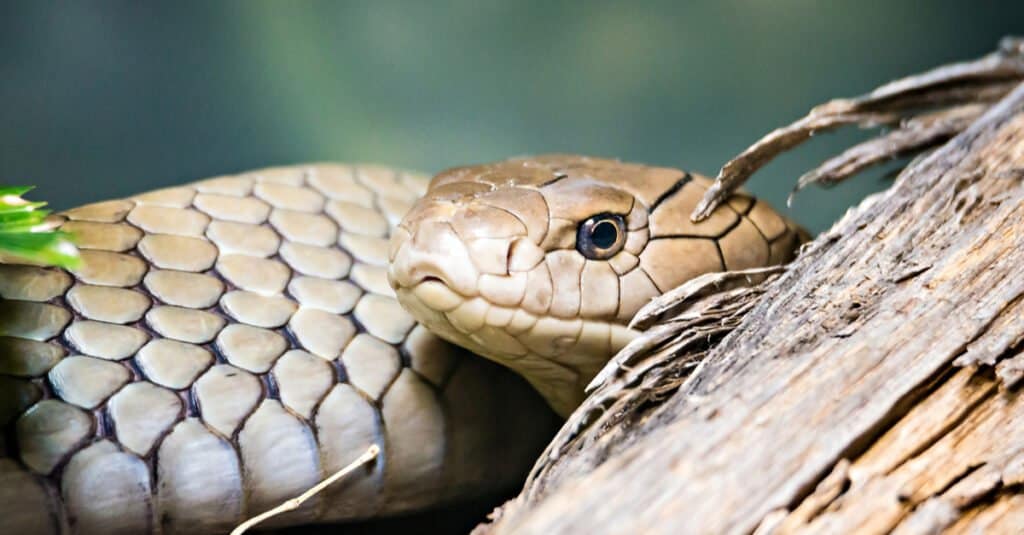
The pine snake is easily identifiable by its small head.
©digidreamgrafix/Shutterstock.com
While most of these subspecies are thriving in the wild, the black pine (Louisiana pine), says otherwise. This subspecies has sadly been declared endangered internationally and is declared threatened in the United States. This is due to the loss of longleaf pine forests. Due to limited space within these dwindling forests, the snakes do not have favorable habitats to nest or hunt in, causing a decline in these already rare subspecies. Thankfully, after a long wait since the 1980s, this subspecies is protected under the Endangered Species Act.
You can do your part in helping this endangered snake species by not approaching or intentionally harming them if you see them in the wild. Move slowly and back away if you approach one and make sure to call animal control if you are wanting them out of your yard. Snakes are an essential part of our ecosystem and even having one nearby can do wonders if you have a pest problem!
Other Record-Breaking Snakes

Coachwhip snakes are found in the Americas
©Patrick K. Campbell/Shutterstock.com
The coachwhip snake is a non-venomous species that can be found in North America, ranging from southern Canada all the way down to Central America. These snakes are known for their remarkable agility and speed, making them one of the fastest reptiles in the world. However, they also tend to be quite elusive and difficult to spot due to their excellent camouflage abilities.
When it comes to record-breaking coachwhips, there is one notable specimen that stands out. The largest coachwhip ever recorded was nearly a whopping 9 feet long! This giant snake was discovered in Texas and measured at an impressive length of 108 inches. To put this into perspective, most adult coachwhips only grow between 4-6 feet in length.
Despite its massive size, this record-breaking coachwhip was still able to move with incredible speed and agility thanks to its slender body shape and powerful muscles. While these snakes may not get as much attention as some other species, like rattlesnakes or pythons, they are certainly worth admiring for their unique adaptations and impressive physical capabilities.
Discover the "Monster" Snake 5X Bigger than an Anaconda
Every day A-Z Animals sends out some of the most incredible facts in the world from our free newsletter. Want to discover the 10 most beautiful snakes in the world, a "snake island" where you're never more than 3 feet from danger, or a "monster" snake 5X larger than an anaconda? Then sign up right now and you'll start receiving our daily newsletter absolutely free.
Thank you for reading! Have some feedback for us? Contact the AZ Animals editorial team.

